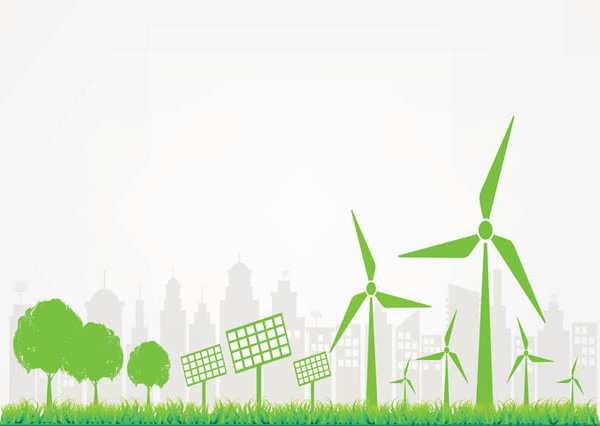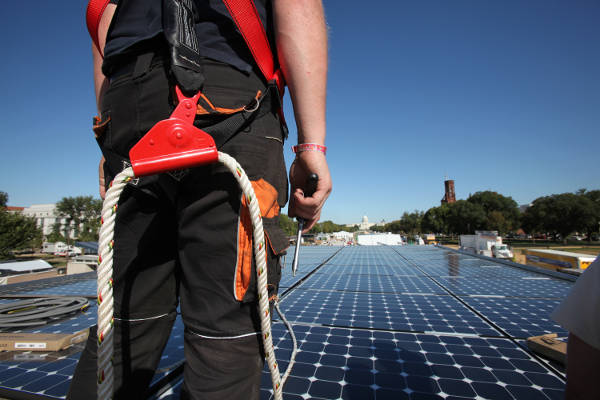Washington DC – According to a review by the SUN DAY Campaign of data released – quietly – by the Federal Energy Regulatory Commission (FERC) for the first three-quarters of 2019, solar and wind provided nearly six times as much new generating capacity as natural gas in September. New capacity placed into service that month included 359 megawatts (MW) of wind and 232 MW of solar but only 100 MW of natural gas.
However, FERC’s latest monthly “Energy Infrastructure Update” report (with data through September 30, 2019) also indicates that gas still holds a diminishing lead for 2019 with 52.87% of all new generating capacity compared to 45.14% for the mix of renewables (i.e., wind – 25.46%, solar – 18.49%, hydropower – 0.76%, biomass – 0.43%, geothermal – 0.00%). The balance of new capacity added includes nuclear power (1.06%), oil (0.50%), and coal (0.42%).
But the gap between gas and renewables for calendar year 2019 appears to be closing with additions by the latter outpacing gas during each of the last three months reported (i.e., July, August, September). Moreover, compared to its prior monthly report, FERC’s three-year forecast has reduced its projection of net new natural gas additions (i.e., “proposed additions under construction” minus “proposed retirements”) by 99 MW while increasing those from renewable sources by 1,040 MW.
Net new natural gas additions by September 2022 are projected to be 19,658 MW while the net capacity of coal, nuclear power, and oil are all forecast to suffer significant declines of 18,755 MW, 4,851 MW, and 3,007 MW respectively. Thus, the mix of fossil fuels and nuclear power will experience an overall capacity drop of 6,955 MW. Meanwhile, net new additions by renewables are projected to total 48,451 MW (wind – 28,918 MW, solar – 17,532 MW, hydropower – 1,404 MW, biomass – 317 MW, and geothermal – 280 MW).
If FERC’s data prove to be accurate, renewable energy sources will provide nearly one-quarter (i.e., 24.96%) of the nation’s total available installed generating capacity by September 2022 (compared to 21.78% today) with wind alone accounting for over a tenth (10.45%) and utility-scale solar at 4.64%. The balance will be provided by hydropower (8.23%), biomass (1.31%), and geothermal (0.33%). [1]
FERC also projects that the capacity of new coal plants over the next three years will be zero because none are reported as being under construction. In fact, if FERC’s latest projections become reality, in three years, coal’s share of the nation’s total available installed generating capacity will drop from 21.32% today to 19.09% three years hence.
The FERC report also reveals that – for the first time – installed wind generating capacity (100.85 gigawatts (GW)) has exceeded that of hydropower (100.76 GW). In addition – and again for the first time, installed solar capacity (40.05 GW) is now greater than that of oil (39.85 GW). [2]
Further, the combined installed generating capacity of all renewable sources (261.49 GW) continued to expand its lead over coal (255.90 GW). Renewable energy generating capacity is also now nearly 2.5 times more than that of nuclear power (106.33 GW) and over six times greater than that of oil (39.85 GW). Only natural gas’ installed generating capacity (534.77 GW) exceeds that of renewables.
The continued growth in new renewable energy generating capacity is roughly matched by growth in actual electrical generation by renewable sources. According to the latest issue of the U.S. Energy Information Administration’s (EIA) “Electric Power Monthly” report (with data through September 30, 2019), the generation of electricity from non-hydro renewables (including distributed solar PV) increased by 6.54% during the first three-quarters of this year compared to the same period in 2018. That slightly surpassed the growth rate for natural gas (6.50%) and was vastly better than that of coal and nuclear which declined by 13.56% and 0.34% respectively.
Small-scale distributed solar PV alone grew by 19.25% – the fastest growth rate for any energy technology – while total solar (i.e., distributed PV, utility-scale PV, and CSP) increased by 13.90%. Wind expanded by 6.78% and provided 6.91% of total U.S. electrical generation. Wind and solar combined accounted for 9.62%. Geothermal also increased – by 3.29% – but biomass dropped by 5.55%.
Including hydropower, which experienced a 6.03% decline, renewably-generated electricity grew by 1.49% and accounted for 18.17% of total generation; it was 17.67% during the first nine months of 2018.













Comments